Documents: Go to download!
User Manual
- Owner's manual - (English)
- Quick Setup Guide - (English)
- User Manual - (English)
- e-Manual - (Spanish)
- Connections
- Using TV
- Smart Features
- TV Viewing
- Precautions and Notes
- System and Support
- Troubleshooting
- Accessibility Guidance
Table of contents
Connections
Connection Guide
- You can view detailed information about external devices that can be connected to the TV.
- Source Connection Guide Try Now
- It shows you how to connect various external devices, such as video devices, game consoles, and PCs using pictures.
- If you select the connection method and an external device, the connection details appear.
- Audio Device: HDMI (ARC), Optical, Bluetooth, Wi-Fi, Wi-Fi Speaker Surround Setup
- HDMI (ARC) is supported by some models. Check the HDMI port name of the purchased product's model.
- Video Device: HDMI
- Smartphone: Screen Sharing (Smart View), SmartThings, Apple AirPlay
- PC: HDMI, Screen Sharing (Wireless), Apple AirPlay
- Input Device: Keyboard, Mouse, USB Gamepad, Bluetooth Device
- Game Console: HDMI
- External Storage: USB Flash Drive, Hard Disk Drive (HDD)
- The connection method and available external devices may differ depending on the model.
- Using HDMI Troubleshooting, you can check the connection to HDMI cable and external devices (takes approximately 2 minutes).
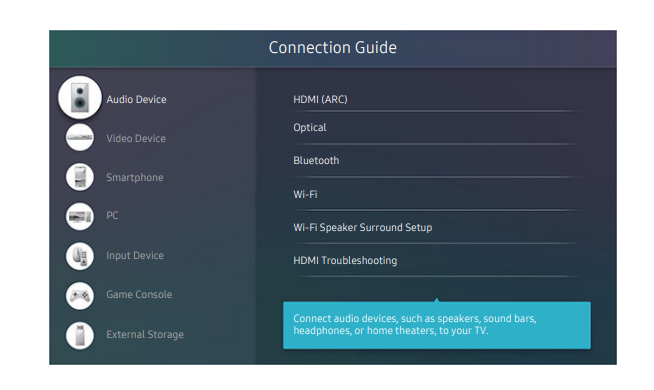
Connecting an Antenna

Connecting to the Internet

- If the TV does not automatically connect to the network, refer to "Network Issues" in "Troubleshooting."
- Use a CAT 7 (*STP type) cable for the connection.
- Shielded Twisted Pair
- The TV will not be able to connect to the Internet if your network speed is below 10 Mbps.
- This function may not be supported depending on the model.
Establishing a wireless Internet connection
- Settings General Network Open Network Settings Wireless Make sure that you have the wireless access point's SSID (name) and password settings before attempting to connect.
- The network name (SSID) and security key are available on the wireless access point's configuration screen. See the wireless access point's user manual for more information
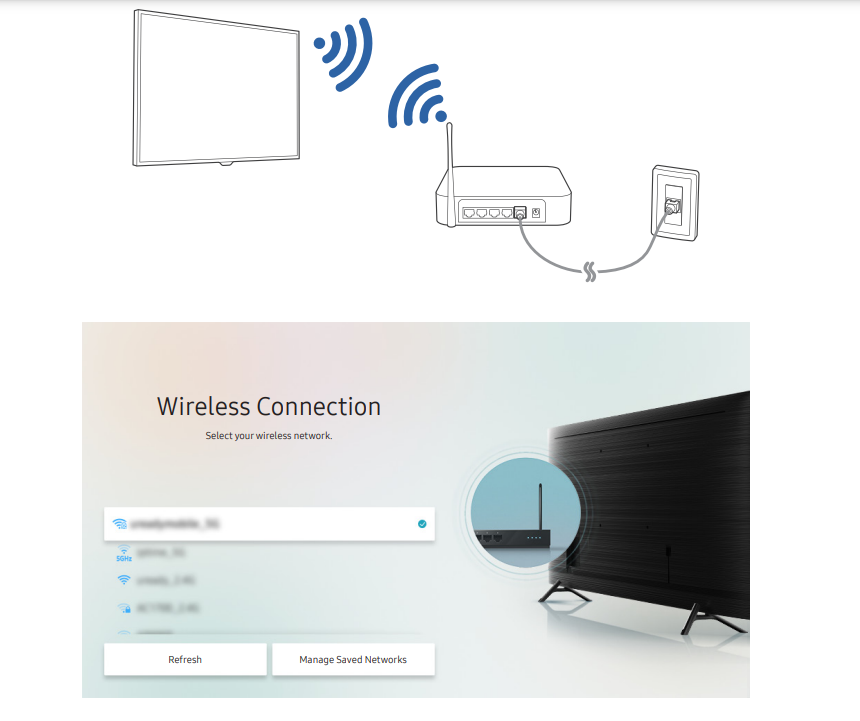
- The image on your TV may differ from the image above depending on the model and geographical area.
- If no wireless access point is found, select Add Network at the bottom of the list and enter the network name (SSID).
- If your wireless access point has a WPS or PBC button, select Use WPS at the bottom of the list, and then push the WPS or
- PBC button on your access point within 2 minutes. The TV will connect automatically.
- To view or delete previously connected network names (SSIDs), move the focus to Manage Saved Networks, and then press the Select button.
Connecting an IP control device to the TV
- Settings General Network Expert Settings IP Remote
- You can connect an IP control device to the TV remotely to manage your IP device.
- To use this function, Power On with Mobile must be turned on.
- Turning this feature on may allow other IP control devices to control your TV. We recommend turning this feature on only if an authorized third-party custom controller is installed and ʀͱ͝fi˝Їθʪʒ ϑΧʪʀ̈fiʀɇ̷̷ц for a Samsung TV and if your Wi-Fi network is password protected.
- This function may not be supported depending on the model.
Connection Cables for External Devices
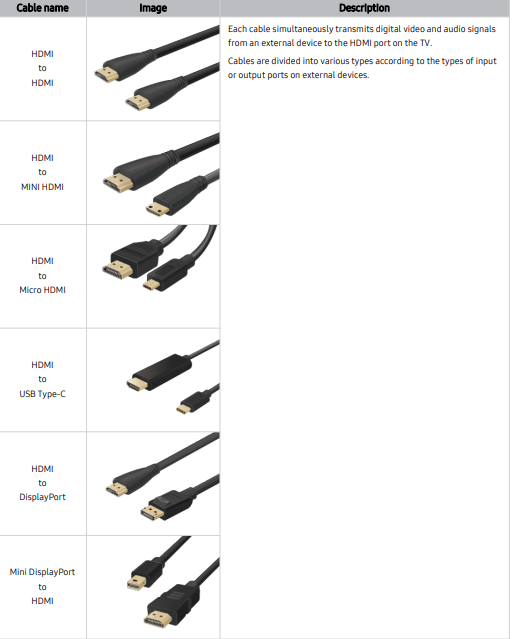
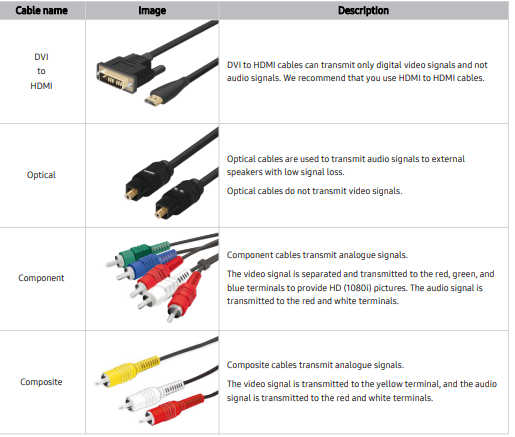
Editing the name and icon of an external device
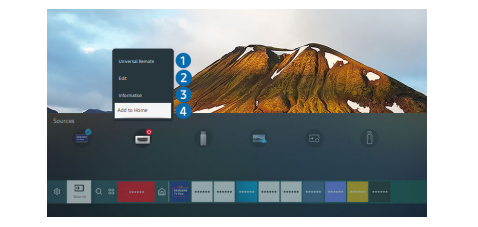
Switching between external devices connected to the TV
Source
- When you select a connected external device on the Source screen, the output of the selected device is displayed on the TV's screen.
- " On the standard remote control, press the SOURCE button. " To control a device (Blu-ray player, game console, etc.) that supports universal remote control with the TV's remote control, connect the device to an HDMI port on the TV, and then turn on the device.
- The output displayed on the TV is automatically switched to the output of the device or you can configure universal remote control for the device automatically. For more information, refer to "Controlling External Devices with a Samsung Remote Control -
- Using the Universal Remote." " When a USB device is connected to the USB port, a pop-up message appears that lets you switch easily to the media content listed on the device. " This function may not be supported depending on the device and geographical area.
Using additional functions
- You can use the following features on the Source screen.
- Remote Access
- Use the TV to access your PC via remote PC or Screen Sharing (Wireless).
- For more information, refer to "Using the Remote Access."
- Connection Guide
- Displays device connection instructions.
Universal Remote
- Lets you register external devices to your Samsung remote control and control them using the Remote.
- This function may not be supported depending on the model or geographical area.
- For more information, refer to "Controlling External Devices with a Samsung Remote Control - Using the Universal
Connection notes for HDMI
- The following types of HDMI cables are recommended:
- High Speed HDMI Cable
- High Speed HDMI Cable with Ethernet
- Premium High Speed HDMI Cable
- Premium High Speed HDMI Cable with Ethernet
- Ultra High Speed HDMI Cable
- Use an HDMI cable with a thickness of 0.66 inches (17 mm) or less.
- Using a non-certified HDMI cable may result in a blank screen or a connection error.
- Some HDMI cables and devices may not be compatible with the TV due to different HDMI specifications.
- This TV does not support HDMI Ethernet Channel. Ethernet is a Local Area Network (LAN) built with coaxial cables standardized by the IEEE.
- Use a cable shorter than 10 feet (3 m) to get the best UHD viewing quality.
- Many computer graphics adaptors do not have HDMI ports, but have DVI or DisplayPort ports instead. If your
- PC does not support HDMI video out, connect your PC with a DVI to HDMI or HDMI to DisplayPort cable.
- When the TV is connected to an external device such as a DVD/BD player or a set-top box via HDMI, power sync mode will be automatically activated. In the power sync mode, the TV continues to detect and connect external devices via HDMI cable. This function can be deactivated by removing the HDMI cable of the connected device.
Connection notes for audio devices
- For better audio quality, it is a good idea to use an AV receiver.
- If you connect an external audio device using an optical cable, the Sound Output setting is automatically changed to the connected device. However, to make this happen, you must turn on the external audio device before connecting the optical cable. To manually change the Sound Output setting, do one of the following:
- Use the Quick Settings screen to change to the connected device:
- Use the Select button to select Optical on the Sound Output menu. ( Settings up directional button Sound Output).
- Use the Settings screen to change to the connected device:
- Select Optical on the Sound Output menu. ( Settings Sound Sound Output).
- An unusual noise coming from a connected audio device while you are using it may indicate a problem with the audio device itself. If this occurs, ask for assistance from the audio device's manufacturer.
- Digital audio is only available with 5.1 channel broadcasts.
Connection notes for computers
- For the resolutions supported by the TV, refer to "Read Before Connecting a Computer (Supported
- Resolutions)."
- If you want to connect your PC and TV wirelessly, both of them must be connected to each other on the same network.
- When sharing content with other network-based devices such as those in an IP (Internet Protocol) storage system, sharing may not be supported due to the network’s configuration, quality, or functionality, for example, if the network has an NAS (Network-Attached Storage) device.
Connection notes for mobile devices
- To use the Smart View function, the mobile device must support a mirroring function such as Screen Mirroring or Smart View. To check whether your mobile device supports the mirroring function, refer to the mobile device's user manual.
- To use Wi-Fi Direct, the mobile device must support the Wi-Fi Direct function. To check whether your mobile device supports Wi-Fi Direct function, refer to the mobile device's user manual.
- The mobile device and your Smart TV must be connected to each other on the same network.
- The video or audio may stop intermittently, depending on network conditions.
- When sharing content with other network-based devices such as those in an IP (Internet Protocol) storage system, sharing may not be supported due to the network’s configuration, quality, or functionality, for example, if the network has an NAS (Network-Attached Storage) device.
Using TV
Using Anynet+ (HDMI-CEC)
- Control an external device connected via Anynet+ (HDMI-CEC) with the remote control.
- You can use the TV's remote control to control external devices that are connected to the TV by an HDMI cable and that support Anynet+ (HDMI-CEC). Note that you can only set up and operate Anynet+ (HDMI-CEC) with the remote control.
- Connecting an external device through Anynet+ and using their menus
- Settings General External Device Manager Anynet+ (HDMI-CEC) Try Now
- Set Anynet+ (HDMI-CEC) to On.
Connect an HDMI-CEC-compliant device to the TV.
- Turn on the connected external device.
- The device is automatically connected to the TV. After the connection process is fï͝ϑ˵ʪʒࡡ you can access the menu of the connected device using your TV remote and control the device.
- The connecting process can take up to 2 minutes to complete.
- Read before connecting an Anynet+ (HDMI-CEC) device
- Anynet+ (HDMI-CEC)-enabled devices must be connected to the TV with an HDMI cable. Note that some HDMI cables may not support Anynet+ (HDMI-CEC).
- You can ʀͱ͝fi˝Їθʪ the TV's Universal Remote to control third-party cable boxes, Blu-ray players, and home theaters that do not support HDMI-CEC. For more information, refer to "Controlling External Devices with a Samsung Remote Control -
Using the Universal Remote."
- Anynet+ cannot be used to control external devices that do not support HDMI-CEC.
- The TV remote control may not work under certain circumstances. If this occurs, set up the device as an Anynet+ (HDMICEC)-enabled device again.
- Anynet+ (HDMI-CEC) works only with external devices that support HDMI-CEC, and only when those devices are either in standby mode or turned on.
- Anynet+ (HDMI-CEC) can control up to 12 compliant external devices (up to 3 of the same type) except for home theaters.
- Anynet+ (HDMI-CEC) can control only one home theater system.
- To listen to 5.1 channel audio from an external device, connect the device to the TV via an HDMI cable and connect a 5.1 home theater system directly to the external device's digital audio output connector.
- If an external device has been set up for both Anynet+ and a universal remote control, the device can be controlled only with the universal remote control.
Connecting a USB keyboard, mouse, or gamepad
- Plug the keyboard, mouse or gamepad cable into the USB port.
- If you connect a mouse, it is available only in the Internet app and Remote Access function.
- XInput USB gamepads are supported.
- For more information, refer to Input Device in Connection Guide ( Source Connection Guide Input Device).
- Connecting a Bluetooth keyboard, mouse, or gamepad
- Settings General External Device Manager Input Device Manager Bluetooth
Device List
- If your device was not detected, position the keyboard close to the TV, and then select Refresh. The TV scans for available devices again.
- If you connect a mouse, it is available only in the Internet app.
- For more information, refer to the Bluetooth device's user manual.
- This function may not be supported depending on the model or geographical area.
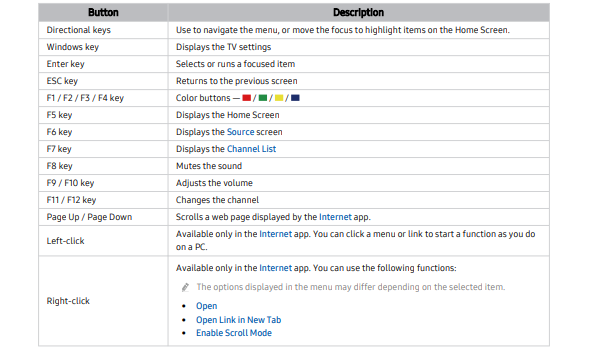
Remote Control and Peripherals
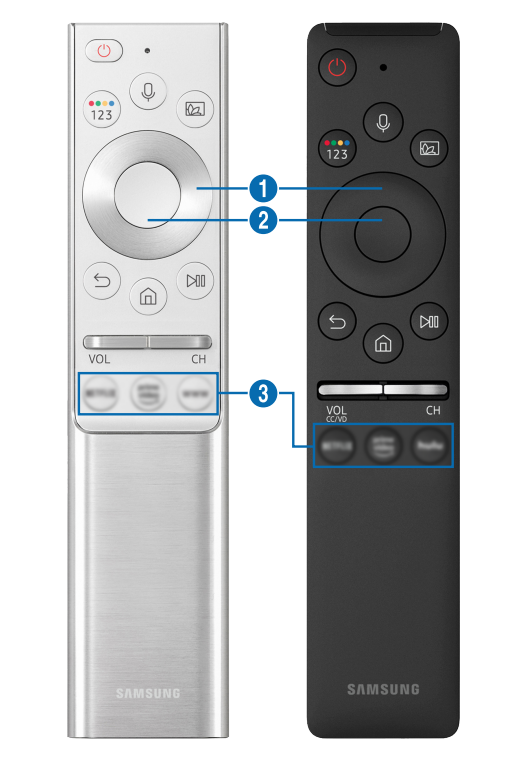
- Use the Samsung Smart Remote less than 20 feet (6 m) from the TV. The usable distance may vary with the wireless environmental conditions.
- The images, buttons, and functions of the Samsung Smart Remote may differ with the model or geographical area.
- The Samsung Smart Remote may not be supported depending on the model or geographical area.
- To use the Samsung Smart Remote to control a compatible external device that does not support HDMI-CEC (Anynet+), you must configure universal remote control for the device. For more information, refer to "Controlling External Devices with a
- Samsung Remote Control - Using the Universal Remote."
- To use the Samsung Smart Remote to control a compatible external device that does support HDMI-CEC (Anynet+), connect the device to an HDMI port on the TV using an HDMI cable. For more information, refer to "Using Anynet+ (HDMICEC)."
- For Q50R model, refer to "About the Samsung Smart Remote (UHD TV and Q50R model).
Connecting to the Samsung Smart Remote
When you turn on the TV for the first time, the Samsung Smart Remote pairs to the TV automatically.
- If the Samsung Smart Remote does not pair to the TV automatically, point it at the front of the TV, and then press and hold the and buttons simultaneously for 3 seconds or more.
- " The images, buttons, and functions of the Samsung Smart Remote may differ with the model or geographical area. " The Samsung Smart Remote may not be supported depending on the model or geographical area.
Controlling External Devices
- This function may not be supported depending on the model or geographical area.
- You can also use the Anynet+ (HDMI-CEC) function to operate external Samsung devices with your TV's remote control without any additional setup. For more information, refer to "Using Anynet+ (HDMI-CEC)."
- Specific external devices connected to the TV may not support the universal remote feature.
- Do not place any obstacles in front of an external device and TV's logo. It may cause signals from the remote control to be transmitted improperly.
- The TV memorizes both the external device and its connection port (HDMI 1, HDMI 2, etc.).
- If you have difficulty controlling external devices with the Universal Remote, try adjusting the positions of the external devices.
- This function may not operate properly depending on the TV installation environment and the features of external devices.
Using Anynet+ (HDMI-CEC)
- Control an external device connected via Anynet+ (HDMI-CEC) with the remote control.
- You can use the TV's remote control to control external devices that are connected to the TV by an HDMI cable and that support Anynet+ (HDMI-CEC). Note that you can only set up and operate Anynet+ (HDMI-CEC) with the remote control.
Connecting a USB keyboard, mouse, or gamepad
- Plug the keyboard, mouse or gamepad cable into the USB port.
- " If you connect a mouse, it is available only in the Internet app and Remote Access function. " XInput USB gamepads are supported. " For more information, refer to Input Device in Connection Guide
Smart Features
Using Smart Hub
- View descriptions of Smart Hub's basic functions. From Smart Hub, you can use the Internet search function, install and use various apps, view photos and videos, or listen to music stored on external storage devices, and perform more functions. " Some Smart Hub services are paid services.
- " To use Smart Hub, the TV must be connected to the Internet. " Some Smart Hub features may not be supported depending on the service provider, language, or geographical area. " Smart Hub service outages can be caused by disruptions in your Internet service.
- " To use Smart Hub, you must agree to the Smart Hub service agreement and the collection and use of personal information. Without giving consent, you cannot use the additional features and services.
- You can view the entire text of the Terms & Policy by navigating to Settings Support Terms & Policy.
- Try Now " If you want to stop using Smart Hub, you can cancel the agreement. To cancel the Smart Hub service agreement, select Reset Smart Hub ( Settings Support Self Diagnosis Reset Smart Hub).
Displaying the Home Screen
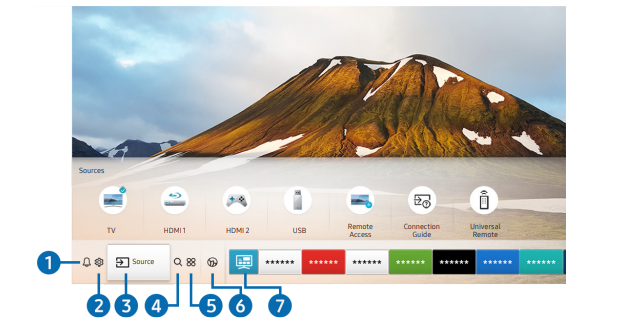
- On the Home Screen, you can easily run the apps you have used previously or frequently. The apps can also be moved or deleted from the screen.
- Notification You can view a list of notifications for all events that occur on your TV.
- A notification appears on the screen when it is time to view a scheduled program or when an event occurs on a registered device. If you move the focus to Notification, and then press the Select button, a notification window appears on the right and the following functions are available:
Picture Mode
- You can select the picture mode that provides the best viewing experience. To change the picture mode, press the Select button. To make fine adjustments, press the up directional button, and then select Picture Setup.
Sound Mode
- You can select a sound mode to optimize your listening experience. To change the sound mode, press the
- Select button. To make fine adjustments, press the up directional button, and then select Equalizer Setup.
Sound Output
- You can select which speakers the TV uses for audio output. To change the audio output, press the Select button. To connect to a Bluetooth speaker, press the up directional button, and then select Bluetooth Speaker
Ambient Mode
- You can enhance your living space with decorative content that matches the surroundings or view essential realtime information such as weather, time, and news on the TV screen when you are not watching TV.
- To enter Ambient Mode, press the button. To return to the TV mode, press the button. To shut off the TV, press the button.
- If you press the button when the TV is turned off, the TV turns on in Ambient Mode.
- If you use a remote control other than the Samsung Smart Remote, there may be restrictions to entering Ambient Mode.
- Because this function is specific to QLED TV (except for Q50R model) and The Serif, it may not be supported depending on the model.
- For more information about the Ambient Mode, refer to "Using the Ambient Mode."
TV Viewing
Using the Guide

- The image on your TV may differ from the image above depending on the model and geographical area.
- In the Guide, you can see the daily program schedules for each station, see program information, choose a program to watch, and set up a schedule viewing.
- To view the Guide while watching TV, press the (Channel) button on the Samsung Smart Remote or press the GUIDE button on the standard remote control.
- To see information about analog channels and use the analog channel functions of the Guide, you must fï͝ϑ˵ the service provider settings in initial setup.
To view the Guide, you must fiθϑϩ set the TV's clock
- Using the schedule viewing options from the guide screen
- On the Guide screen, select a program you would like to view, press and hold the Select button, and then select
- Schedule Viewing in the pop-up menu that appears.
Using the schedule viewing options while watching a program
- Press the Select button while watching TV. The Program Info window appears. Select a program that will be broadcast using the left or right directional buttons.
- Press the Select button, and then select Schedule Viewing to schedule viewing of that program.
Using the Channel List
- Change the channel or check programs on other digital channels.
Live TV Channel List
- Using the Channel List, you can change the channel or check programs on other digital channels while watching TV.
The Channel List screen contains the following icons:
A favorite channel
- If you press the left directional button when viewing the Channel List screen, you can use the following functions:
Air or Cable
- To select Air or Cable, move the focus to Air or Cable, and then press the Select button. Air is suitable for homes equipped with separate, over-the-air antennas
- Cable is suitable for homes that subscribe to a local cableservice, but do not have a cable box. You do not need to use this function if your TV is connected to a cable box or satellite box
Create a favorites list
- Live TV Channel List Edit Channels
- Press the left directional button on the remote control to select the desired Favorites list.
- Press the right directional button to select Add Channels.
- Select the desired channel in the list on the screen.
- Press Add Channels to add the selected channel in the Favorites list.
Using Program Rating Lock
- Settings Broadcasting Program Rating Lock Settings Try Now
- This function is useful for controlling what programs children can watch on the TV based on their ratings. Program
- Rating Lock Settings does not, however, block programs originating from external sources, such as Blu-ray players,
DVD players, or USB
- Every time you access Program Rating Lock Settings, you must enter the security PIN. You must also enter this PIN to watch a blocked program. The default PIN is "0000." To change the PIN, go to Settings General
- System Manager Change PIN.
Using Remote Access

Connecting a Remote PC
- Provides Remote Desktop Connection (RDP) for remotely connecting to a PC running on Windows and Virtual
- Network Computing (VNC) for a PC running on Mac. To remotely connect to a PC, you must enter the IP address of the remote PC or select a saved Χθͱfi̷ʪࢋ Enter a correct username and password and select a correct protocol. If there is any computer that can be accessed via the same network, the found IP and protocol are displayed.
- To register a frequently used PC, move the focus to Manage User ťθͱfi̷ʪϑ, and then press the Select button. When a popup window appears, select Add, and then enter the PC information.
- To use this function, you must select Allow remote connections to this computer in advance on the Windows PC you want the TV to connect to.
- When your PC enters in power saving mode, connection is not available. It is recommended to cancel the power saving mode.
Windows OS:
- Right-click the My Computer icon on Desktop or Windows Explorer and then click Properties.
- Click Advanced System Settings. The System Properties window appears.
- Click the Remote tab and then select the Allow Remote Assistance connections to this computer.
Mac OS:
- Select Menu System Preferences and then click Sharing.
- Select the Screen Sharing check box.
- Run the resolution changing app downloaded from App Store and then change the resolution to 1440 x 900 or lower.
- If you do not change the resolution in Mac OS, the previous image may appear while connecting a remote computer.
- Remote connection to a PC running on Windows via the RDP protocol is only supported for Windows 7 or later. And the operating system must be a Professional or higher edition.
- Remote connection to a PC running on Mac via the VNC protocol is only supported for Mac OS X 10.5 or later.
- It is recommended to connect the wired network because the screen or sound may be interrupted depending on the network condition.
- Playing Multimedia Content on a Remote PC
- When you move the mouse cursor to the top of the screen after accessing a remote computer, the top bar appears.
- When the sharing folder icon is clicked in the top bar, the folders shared on Windows or Mac OS appear. You can play back any media content in a folder.
- For more information, refer to "Playing pictures/video/music."
- To use this function, the folder sharing option on the computer to access must have been enabled as shown below:
Windows OS:
- Run Windows Explorer and then move to the folder to share.
- Right-click the folder and then click Properties.
- After the Properties window appears, click the Sharing tab and then click Advanced Sharing.
- After the Advanced Sharing window appears, select the Share this folder check box.
Mac OS:
- Select Menu System Preferences and then click Sharing.
- Select the File Sharing check box.
- To add a folder to share, click the Add+ button at the bottom.
- Select a folder and then click Add+.
Using Cloud Service
- You can access the cloud service by selecting the cloud service icon added to Remote Access.
- The screen on the web page may differ from that of a computer.
- You can copy or paste any text. Some image formats are supported.
- For easy and secured login in Cloud Service, Remote Access Pass is additionally supported as well as Samsung Pass.
- Setting Samsung Pass or Remote Access Pass.
- Set Samsung Pass or Remote Access Pass to Use in Source Remote Access Run the Remote Access browser
- Additionally select Į˙fiʀʪ 365 or Add Cloud Service) Internet Menu Settings.
- Remote Access Pass allows you to easily manage the cloud service ID and password without biometric authentication on mobile devices. For this purpose, you must be signed in to your Samsung account. The password is encrypted to be safely stored on your TV.
- However, the log in to Remote Access Pass may not work depending on the site policy.
- To securely access the cloud service, you can use the browser's automatic shutdown or clear the history logs.
- Before accessing the cloud service, refer to "Read Before Using the Internet Function."
The cloud service supports the following keyboard shortcuts:
F1: Returns to Remote Access's Home screen.
F8: Mutes the sound.
F9/F10: Adjusts the volume.
F11: Switches between full screen or default screen.
Using the Apps Service
- Download and run various apps from Smart Hub.
Apps
- You can enjoy a wide range of content, including news, sports, weather, and games by installing the corresponding apps on your TV.
- To use this feature, the TV must be connected to the Internet.
- When Smart Hub is launched for the fiθϑϩ time, the default apps are automatically installed. The default apps may differ depending on the geographical area.
- It is recommended to use the landscape mode in some apps for The Frame
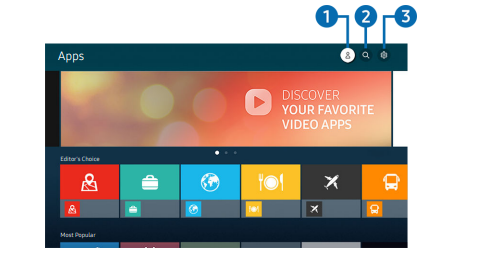
Installing an app
- Move to the app you want to install, and then press the Select button. The detailed information screen appears.
- Select Install. When the installation is complete, the Open menu appears.
- Select Open to run the app immediately.
- You can view installed apps on the Settings screen.
- If the TV's internal memory is ̈͝ϑЇ˙fiʀ̈ʪ͝ϩࡡ you can install some ϑΧʪʀ̈fiʀ apps on a USB device.
- You can run an app installed on a USB device only when the USB device is connected to the TV. If the USB device is disconnected while an app is running, the app is terminated.
- You cannot run an app installed on a USB device on a PC or another TV.
Launching an app
- You can run the app desired from Downloaded App.
- The icons below appear within the selected app's icon and indicate the following:
- The app is installed on a USB device.
- The app has a password.
- The app needs to be updated.
- The app supports the mirroring functio
Using the Gallery App

- You can enjoy various content synchronized with a mobile device that supports the Samsung Cloud. The available content types are photos, videos, stories, and other content shared through your groups.
- If you have shared content from your groups, you can access them in ͝ͱϩ̈fiʀɇϩ̈ͱ͝ϑࢋ
- To use the Gallery app, you must be signed in to your Samsung account that uses the Samsung Cloud.
Open category
- Move to at the top left of the screen using the directional buttons on the remote control to view by category the content synchronized with the Samsung Cloud.
- View: Daily / View: Monthly
- Sort the content by day or month.
Samsung Account
- Go to the Samsung Account screen to create a new account or sign out of your account.
- If you are signed out of your Samsung account, select Sign In to sign in.
Gallery Settings
- Set a PIN for screen lock to restrict access to the Gallery app, or view the terms and condition.
Using the SmartThings App
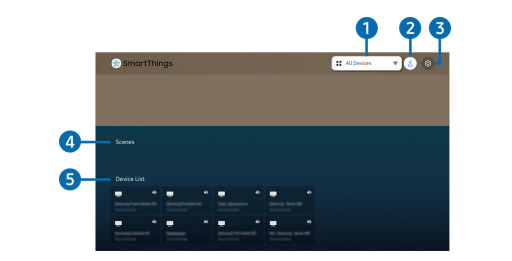
- From your TV, you can monitor and ʀͱ͝fi˝Їθʪ smart devices you connected to the SmartThings service via the
- SmartThings app installed on them. You can receive ͝ͱϩ̈fiʀɇϩ̈ͱ͝ϑ about the statuses of your connected devices.
- To use this function, you must be logged in to your Samsung account.
- This function may not be supported depending on the model or geographical area.
Location selection list
- Press the Select button to identify all connected devices or the devices ϑΧʪʀ̈fiʀ to a location.
Samsung Account
- Go to the Samsung Account screen to create a new account or sign out of your account.
- If you are signed out of your Samsung account, select Sign In to sign in.
- Device list View a list of the connected smart devices and their statuses. You can add and control new devices through the SmartThings app on your mobile device.
- You can check and control various devices, such as speakers, smart devices (IoT devices), and home appliances registered on the server. Please refer to the user guide of the SmartThings app on your mobile device for more details.
Using the buttons in the e-Manual
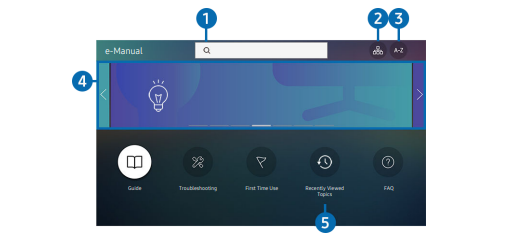
- Select an item from the search results to load the corresponding page. Sitemap)
- It displays the lists for each item in e-Manual. Index)
- Select a keyword to navigate to the relevant page.
- This function may not be supported depending on the model or geographical area.
Moving to FAQ
- You can fi͝ʒ the troubleshooting of the selected symptom.
- Recently Viewed Topics)
- Select a topic from the list of recently viewed topics.
Using the Internet
- Surf the Internet on your TV. Internet
- When you run Internet, you can see recently viewed web sites or featured recommendations. When you select a desired web site, you can get immediate access to it.
- You can use the Internet function more easily after connecting a keyboard and mouse.
- The web pages may differ from those on a PC.
- Before using the Internet, refer to "Read Before Using the Internet Function."
- The Internet app has an embedded Samsung Pass ( Internet Internet Menu Samsung Pass Settings). With
- Samsung Pass, you can log into the website easily and securely. When you visit the website again, you can log in with
- Samsung Pass Biometrics Authentication on your mobile device without entering your ID and password. However, this
- Samsung Pass login may not work depending on the website policy. For this purpose, you must have been logged in the mobile device with a Samsung account registered in Samsung Pass.
Playing pictures/video/music
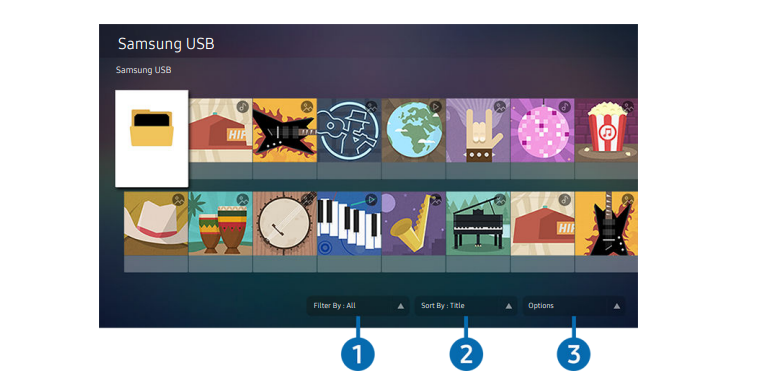
- The image on your TV may differ from the image above depending on the model and geographical area.
- You can play media content saved on storage devices, such as USB devices, mobile devices, and cameras on the TV.
- You cannot play media content if the content or the storage device is not supported by the TV. For more information, refer to "Read Before Playing Photo, Video, or Music Files."
- Backup important fi̷ʪϑ before connecting a USB device. Samsung is not responsible for damaged or lost fi̷ʪϑࢋ
- You can use the following functions on the media content list screen of a storage device.
- Playing multimedia content on a PC or mobile device
- Select a device with media content in Source. The media content list in the device appears.
- Select a media content item from the list.
The selected content is played.
- The content may not be played depending on the encoding method or fi̷ʪ format. Furthermore, several functions may be restricted.
- Content on devices connected to the TV via your network may not play smoothly due to network communication problems.
- If this occurs, use a USB device.
- Playing multimedia content on a USB device
- Connect a USB device to the USB port.
- When a pop-up message appears on the screen, select Browse to easily move to the list of multimedia content stored on the device.
- If a USB device that contains the content you want to play is already connected to the TV, select the USB device in the
Source screen.
- Select a content item to play from the list.
- The selected content is played.
- Listening to your mobile device sound through the TV speaker using Sound Mirroring
- Search for and connect to your TV from the (Bluetooth) device list on your mobile device.
- Select media content to play on your mobile device.
- The selected media is played through the TV speaker.
- If the TV and the sound bar are connected wirelessly, the operation may be restricted.
- This function may not be supported depending on the model or geographical area.
- Buttons and functions available while playing multimedia content
- Press the Select button while playing any video, or photo content. The following buttons appear.
- The provided buttons and functions may not be supported depending on the model or geographical area.
- The available buttons and functions may differ with the content you are viewing or playing.
Pause, Play
- Pauses or plays the multimedia content.
- Jump Backward, Jump Forward
- Press the up directional button to move the focus to the playback control bar, and then select the left or right directional button in the playback control bar to move backward or forward by 10 seconds in the video.
Using Bixby
- Speak into the microphone on your Samsung Smart Remote to control your TV.
- This function is supported only in The Frame.
- Bixby is available only when the TV is connected to the Internet.
- To use Bixby, you must register and sign in to your Samsung account. Some functions may not be supported if you are not signed in to your Samsung account.
- Bixby only supports some languages, and the supported functions may differ depending on the geographical area.
- Bixby may not be supported depending on the geographical area.
Starting Bixby with voice
- You can immediately start a conversation with Bixby by saying "Hi, Bixby." Say "Hi, Bixby," and the Bixby icon at the bottom of the TV screen is activated in Listen mode. Continue speaking.
- Starting Bixby using buttons on the Samsung Smart Remote
- You can also have a conversation with Bixby using the Samsung Smart Remote buttons. Press and hold the button on your Samsung Smart Remote, say a command, and then release the button.
To view the Bixby guide, press the button once:
When you press the button, the Explore Now button appears at the bottom of the screen. Press the Select button to go to the Explore Bixby screen.
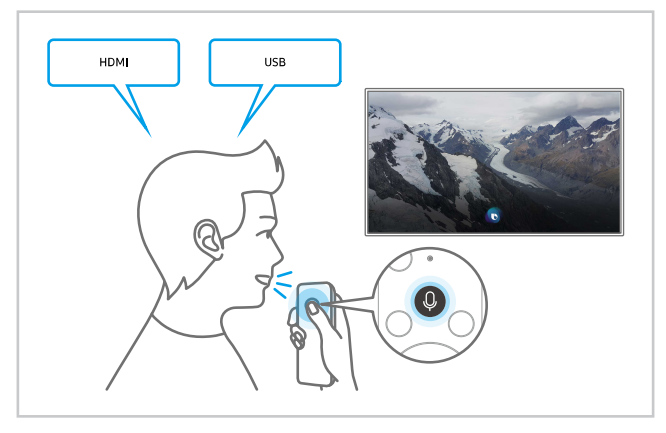
Learning about the Explore Bixby Screen
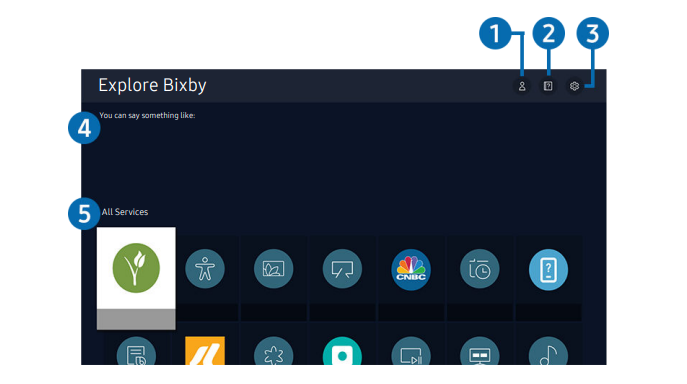
- Go to the My ťθͱfi̷ʪ screen to create a new account or register a voice ID. When a voice ID is registered, you can log in with your voice and see the icon that Bixby generated for your voice.
- You can delete a voice ID after selecting My ťθͱfi̷ʪ. When the voice ID is deleted, its icon also disappears.
- If you are signed out of your Samsung account, select My ťθͱfi̷ʪ to sign in.
Tutorials
- The pop-up window on using Bixby appears.
Settings
- You can change the settings for using Bixby.
- These functions may not be supported depending on the geographical area.
- These functions can be set in Bixby Voice settings ( Settings General Voice Bixby Voice settings).
Language
- You can change Bixby's language.
- The languages of the TV and other apps will not change.
- Bixby only supports some languages.
- Read Before Using Bixby
- The supported voice interaction languages and features may differ depending on the geographical area.
- If the language set differs from the language of your country, some features are not available.
- Bixby is available only when the TV is connected to the Internet.
- Even if the TV is connected to the Internet, there may be no response due to a Bixby server error.
- The existing functional specifications may be changed if Bixby is updated.
- Bixby is available only on TVs that support it and come with remote controls that have a microphone.
- Symbols including "-" and special characters are not supported. Consequently, if a word or sentence contains numeric values or symbols, the function may not operate properly.
- Searched results may not provide complete results.
- You may be required to pay for some apps. Consequently, you may encounter a service application or contract.
- To change the current channel by saying channel names as voice commands, you must finish Set Up Your Service
- Provider. If Set Up Your Service Provider is not completed, you can complete it using Reset ( Settings General Reset). Try Now
- To use the voice text input function and the search function, you must consent to provisions allowing third parties to collect and use your voice data.
To use the Bixby function, you must:
- Agree to Smart Hub's Terms of Use.
- Agree to a guidance regarding the collection and use of personal information for the Smart Hub service.
- Consent to the collection and use of personal information for the voice interaction-based service.
- Provisions for using Bixby
- The voice interaction rate differs with the volume/tone, pronunciation, and ambient sound environment (TV sound and ambient noise).
- The optimal volume for voice commands is between 75 dB and 80 dB.
TV Viewing
Using the Guide
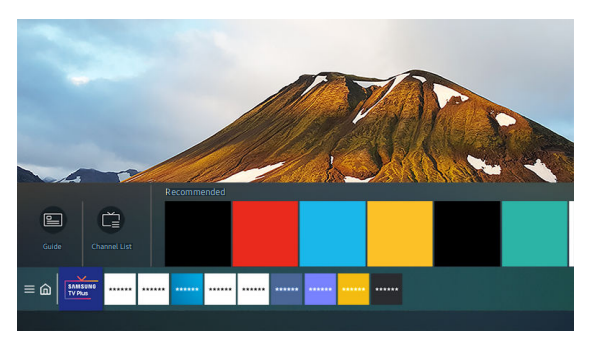
- See an overview of each channel's program lineup.
- Live TV Guide Try Now
- Guide Channel List
- Recommended
- The image on your TV may differ from the image above depending on the model and geographical area.
- In the Guide, you can see the daily program schedules for each station, see program information, choose a program to watch, and set up a schedule viewing.
- To view the Guide while watching TV, press the (Channel) button on the Samsung Smart Remote or press the GUIDE button on the standard remote control.
- To see information about analog channels and use the analog channel functions of the Guide, you must fï͝ϑ˵ the service provider settings in initial setup.
- To view the Guide, you must fiθϑϩ set the TV's clock ( Settings General System Manager Time Clock).
- Using the schedule viewing options from the guide screen
- On the Guide screen, select a program you would like to view, press and hold the Select button, and then select
- Schedule Viewing in the pop-up menu that appears.
- Using the schedule viewing options while watching a program
- Press the Select button while watching TV. The Program Info window appears. Select a program that will be broadcast using the left or right directional buttons. Press the Select button, and then select Schedule Viewing to schedule viewing of that program.
Using the Channel List
- Change the channel or check programs on other digital channels.
Live TV Channel List
- Using the Channel List, you can change the channel or check programs on other digital channels while watching TV.
- The Channel List screen contains the following icons:
A favorite channel
If you press the left directional button when viewing the Channel List screen, you can use the following functions:
Air or Cable
- To select Air or Cable, move the focus to Air or Cable, and then press the Select button. Air is suitable for homes equipped with separate, over-the-air antennas.
- Cable is suitable for homes that subscribe to a local cableservice, but do not have a cable box. You do not need to use this function if your TV is connected to a cable box or satellite box.
- This function may not be supported depending on the incoming broadcast signal.
All Channels
- Displays the channels that the TV found during the Auto Program channel search.
- These are the channels your TV will receive either over the air if your TV is set to Air or over cable if your TV is set to
- Cable. See Air or Cable above.
- Favorites
- Displays Favorites 1 to Favorites 5.
- It displays only the favorites list that includes the favorite channel.
Samsung TV Plus
- While the TV is connected to the Internet, you can watch popular programs or highlights for each theme through a virtual channel at any time. As with regular channels, the TV provides the daily program schedules for Samsung TV Plus.
- Create a favorites list
- Live TV Channel List Edit Channels
- Press the left directional button on the remote control to select the desired Favorites list.
- Press the right directional button to select Add Channels.
- Select the desired channel in the list on the screen.
- Press Add Channels to add the selected channel in the Favorites list.
Using Program Rating Lock
- Settings Broadcasting Program Rating Lock Settings Try Now
- This function is useful for controlling what programs children can watch on the TV based on their ratings. Program
- Rating Lock Settings does not, however, block programs originating from external sources, such as Blu-ray players,
DVD players
- Every time you access Program Rating Lock Settings, you must enter the security PIN. You must also enter this PIN to watch a blocked program. The default PIN is "0000." To change the PIN, go to Settings General
- System Manager Change PIN.
- Program Rating Lock Settings may not be supported depending on your input signal.
- For more information about how to set your password, refer to "Setting up a password."
- For more information about the rating system of different countries, refer to "Blocking programs based on their TV Rating."
Watching blocked / restricted programs
- To watch a blocked program, enter the PIN when requested.
- When initially showing a restricted program or movie, the screen is blank because the Program Rating Lock
- Settings blocks it. Enter the PIN to unblock the program when a message appears requesting the code.
- Aͱ͝fi˝Їθ̈͝˝ advanced broadcasting audio settings
- Settings Broadcasting Audio Options
- Audio Options functions differently for analog and digital channels.
Preferred Language
- This is the language you will hear while watching TV if the language is included in the broadcast signal.
Multi-Track Sound
- You can select the multi-track sound function depending on broadcasting signal.
- This function may not be supported depending on the model or geographical area.
- Playing games on an optimized screen
- Settings General External Device Manager Game Mode
- You can enable game mode to optimize the TV's settings for playing video games with a gaming console, such as a
PlayStation™, Xbox™ or Nintendo Switch™.
- This function may not be supported depending on the model.
- The game mode is not available for normal TV viewing.
- The screen may shake somewhat.
- When Game Mode is enabled, Picture Mode and Sound Mode are switched to Game automatically. Sound Mode may not be automatically switched depending on the selected audio device on the Sound Output menu.
- When Game Mode is set to On, some functions are not available.
- To use a different external device on the same port, remove the game console connection, set Game Mode to Off, and then connect the external device to the port.
- The Game Mode functions used for Nintendo Switch™ are subject to change without prior notice.
Using Input Signal Plus
- Settings General External Device Manager Input Signal Plus Try Now
- Expands the input signal range for HDMI connections.
- When you select the HDMI connector you want to use for Input Signal Plus, and then press the Select button to set the
- Input Signal Plus function to On, the TV screen may fl̈ʀ̧ʪθࢋ
- When you connect the TV to an external device that supports only the UHD 24 Hz or UHD 30 Hz frequency, or any FHD frequency, the Input Signal Plus function may not be available. In this case, turn off the Input Signal Plus function.
- For more information, refer to "Supported Resolutions for UHD Input Signals."
- This function is supported by TU7 series.
Choosing a sound mode
- Settings Sound Sound Mode Try Now
- You can select the available sound mode that you prefer for a content type or your listening environment.
- When an external device is connected, Sound Mode may change accordingly.
- This function may not be supported depending on the model.
- Digital Output Audio Delay Try Now
- This feature is only available when the external device is connected via HDMI (eARC) and SPDIF (Sony Philips Digital Interface).
- HDMI (ARC) is supported by some models. Check the HDMI port name of the purchased product's model.
Dolby Atmos Compatibility Try Now
- You can set the TV to allow Dolby Digital+ with Atmos streams that are input from external devices.
- Set to On if the audio device connected via HDMI (eARC) supports Dolby Atmos. The TV screen may flicker when this function is turned on or off.
- If this function is on, set Digital Output Audio Format to Auto.
- HDMI (ARC) is supported by some models. Check the HDMI port name of the purchased product's model.
- Listening to the TV through Bluetooth devices
Settings Sound Sound Output Bluetooth Speaker List
- You can connect Bluetooth audio devices to the TV. They must be paired using the TV's Bluetooth function. Refer to the user manual for your audio device such as Bluetooth speaker, sound bar, and headphones for detailed connection and usage.
- If the TV fails to fi͝ʒ a Bluetooth audio device, place the device closer to the TV, and then select Refresh.
- When you turn on a paired Bluetooth audio device, the TV detects it automatically, and then displays a pop-up window. Use this pop-up window to activate or deactivate the Bluetooth audio device.
- The sound quality may be affected by the condition of the Bluetooth connection.
- Before using a Bluetooth audio device, refer to "Read Before Using Bluetooth Devices."
- This function may not be supported depending on the model.
- Listening to the TV through a Samsung audio device that supports the Wi-Fi function
- For more information about how to connect and use a Samsung audio device that supports the Wi-Fi function, refer to its user manual.
Settings Sound Wi-Fi Speaker Surround Setup Try Now
- If you've connected one or more Samsung wireless audio devices that support the Wi-Fi function to the TV, you can create an optimal sound set up by ʀͱ͝fi˝Їθ̈͝˝ the surround effect settings. You can select any of the surround sound ʀͱ͝fi˝Їθɇϩ̈ͱ͝ϑࡡ with or without a sound bar.
- A surround sound ʀͱ͝fi˝Їθɇϩ̈ͱ͝ can be used if all of the following conditions are met:
- Two or more Samsung wireless speakers of the same type must be connected to the same wireless network.
- The Samsung audio devices that support the Wi-Fi function must be connected to the same wireless network as the TV.
- Surround sound ʀͱ͝fi˝Їθɇϩ̈ͱ͝ϑ with a sound bar may not be supported depending on the product.
- If you activate the Screen Mirroring function while using Samsung audio devices that support the Wi-Fi function, the Wi-Fi connection is disconnected.
- Mismatched video and audio lip-syncing may occur depending on the device type.
Using the Time Functions and the Timers
- Set the current time and use the timer function.
- Settings General System Manager Time Try Now
- You can set the Clock manually or automatically. Once the Clock is set, you can view the current time on the TV anytime.
- You must set the clock in the following cases:
- The power cable is disconnected and then connected.
- The Clock Mode is changed from Auto to Manual.
The TV is not connected to the Internet.
- No broadcast signals are received
- Setting the clock automatically
- Settings General System Manager Time Clock Clock Mode Auto
- This function works only when the TV is connected to the Internet or is receiving digital broadcasts through a connected antenna.
- The accuracy of the time information received may differ with the channel and signal.
- If you get your TV signal from a cable broadcast receiver/set-top box or a satellite receiver/satellite set-top box connected to an HDMI or Component port, you must set the current time manually
Setting the Auto Protection Time
- Settings General System Manager Auto Protection Time Try Now
- Activate a screensaver when your TV displays a still image for 2 hours or more.
- This function may not be supported in some viewing modes.
- Reducing the energy consumption of the TV
- Settings General Eco Solution Try Now
- You can adjust the brightness level of the TV, reduce overall power consumption, and prevent overheating.
- This function may not be supported depending on the model.
Ambient Light Detection Try Now
- Automatically adjusts the brightness level of the TV, according to the ambient light level, to reduce power consumption.
- If Ambient Light Detection has adjusted the screen brightness to a too bright or dark level, you can select Minimum Brightness to manually adjust the minimum screen brightness.
Minimum Brightness Try Now
- When Ambient Light Detection is turned on, you can manually adjust the minimum brightness of the TV screen.
- This function acts only when the value is less than the setting in Settings Picture Expert Settings
Brightness.
- Power Saving Mode Try Now
- Adjust the brightness settings to reduce the TV's power consumption.
- Motion Lighting Try Now
- Adjusts the brightness in response to on-screen movements to reduce power consumption.
- Auto Power Off Try Now
- Automatically turns off the TV to reduce unnecessary power consumption if the TV Controller and the remote control are not used for the set period of time.
- Updating through a USB device
- Settings Support Software Update Update Now
- After downloading the update fi̷ʪ from the Samsung website and storing it on a USB device, connect the USB device to the TV to update.
- To update using a USB device, download the update package from Samsung.com to your computer. Then, save the update package in the USB device's top-level folder. Otherwise, the TV will not be able to locate the update package.
Updating the TV automatically
- Settings Support Software Update Auto Update Try Now
- If the TV is connected to the Internet, you can have the TV's software update itself automatically while you are watching the TV. When the background update is completed, it is applied the next time the TV is turned on.
- If you agree to the Smart Hub terms and conditions, Auto Update is set to On automatically. If you want this function disabled, use the Select button to turn it off.
- This function may take a longer time if another network function is running concurrently.
- This function requires an Internet connection.
- The TV screen is turned off but audio continues
Settings General Accessibility Picture Off
- Turn off the TV screen and provide only sound to reduce overall power consumption. When you press a button on the remote control other than Volume and Power while the screen is off, the TV screen turns back on.
- Enabling audio for the video description function
- Settings General Accessibility Video Description Try Now
- You can activate an audio guide that provides an audio description of video scenes for the visually impaired. This function is only available with broadcasts that provide this service.
- White text on black background (high contrast)
Settings General Accessibility High Contrast Try Now
- You can change Smart Hub and setting menu screens to white text on a black background and change the transparent TV menus to opaque automatically so that text can be more easily read.
- If High Contrast is on, some Accessibility menus are not available.
- Learning about the remote control (for the visually impaired)
- Settings General Accessibility Learn TV Remote Try Now
- This function helps individuals with a visual impairment to learn the positions of the buttons on the remote control.
- When this function is activated, you can press a button on the remote control and the TV will tell you its name. Press the RETURN button twice to exit Learn TV Remote.
- This function is only available when Voice Guide is enabled.
Precautions and Notes
Read Before Using Apps
- Read this information before using Apps.
- If you want to download new apps using Apps, first sign in to your Samsung account.
- Due to the product characteristics featured on Samsung Smart Hub, as well as limitations in available content, certain features, applications, and services may not be available on all devices or in all territories. Visit http://www.samsung.com for more information on specific device information and content availability. Services and content availability are subject to change without prior notice.
- Samsung Electronics takes no legal responsibility whatsoever for any interruption of app services caused by the service provider for any reason.
- Application services may be provided in English only and available content may differ with the geographical area.
- For more information about applications, visit the applicable service provider's website.
- An unstable Internet connection may cause delays or interruptions. In addition, applications may terminate automatically depending on the network environment. If this occurs, check your Internet connection and try again.
- Application services and updates may become unavailable.
- Application content is subject to change by the service provider without prior notice.
- Specific services may differ with the version of the application installed on the TV.
- An application's functionality may change in future versions of the application. If this occurs, run the application's tutorial or visit the service provider's website.
- Depending on the service provider's policies, certain applications may not support multitasking.
- Read Before Using the Internet Function
- Read this information before using the Internet function.
- File download is not supported.
- The Internet function may not be able to access certain websites, including websites operated by certain companies.
- The TV does not support playback of flash videos.
- E-commerce for online purchases is not supported.
- ActiveX is not supported.
- Only a limited number of fonts are supported. Certain symbols and characters may not be displayed properly.
- The response to remote commands and the resulting on-screen display may be delayed while a web page is loading.
- Loading a web page may be delayed or suspended completely depending on the status of the participating systems.
- Copy and paste operations are not supported.
- When composing an email or a simple message, certain functions such as the font size and color selection may not be available.
- There is a limit to the number of bookmarks and the size of the log file that can be saved.
- The number of windows that can be opened concurrently is limited.
- Web browsing speed will differ with the network environment.
- Browsing history is saved from latest to oldest, with the oldest entries being overwritten first.
- Depending on the types of video/audio codecs supported, you may not be able to play certain HTML5 video and audio files.
- Video sources from PC-optimized streaming service providers may not play properly on our proprietary Internet browser.
Precautions for wireless Internet
- This TV supports the IEEE 802.11 a /b /g /n /ac communication protocols. Samsung recommends using IEEE n. Video files stored on a device connected to the TV via a Home Network may not play back smoothly.
- Some of the IEEE 802.11 communication protocols may not be supported depending on the model or geographical area.
- To use wireless Internet, the TV must be connected to a wireless access point or modem. If the wireless access point supports DHCP, the TV can use a DHCP or static IP address to connect to the wireless network.
- Select a channel that is not currently being used by the wireless access point. If the channel set is currently being used by the wireless access point to communicate with another device, the result is usually interference and/or a communications failure.
- Most wireless networks have an optional security system. To enable a wireless network's security system, you need to create a password using characters and numbers. This password is then needed to connect to a securityenabled access point.
- Wireless security protocols
- The TV only supports the following wireless network security protocols. The TV cannot connect to ͝ͱࣗ͝ʀʪθϩ̈fiʪʒ wireless access point.
- Authentication Modes: WEP, WPAPSK, WPA2PSK
- Encryption Types: WEP, TKIP, AES
- In compliance with the Wi-Fi Samsung TVs do not support WEP or TKIP security encryption in networks running in the 802.11n mode. If the wireless access point supports WPS (Wi-Fi Protected
- Setup), you can connect the TV to your network using PBC )
- Limitations to the use of photo, video, and music fi̷ʪϑ Try Now
- The TV supports Mass Storage Class (MSC) USB devices only. MSC is a class designation for mass storage devices.
- Types of MSC devices include external hard drives, flash card readers, and digital cameras. (USB hubs are not supported.) These kinds of devices must be connected directly to the USB port. The TV may not be able to recognize a USB device or read the files on the device if it is connected with a USB extension cable. Do not disconnect USB devices while they are transferring files.
- When connecting an external hard drive, use the USB (HDD 5V 1A) port. We recommend that you use an external hard drive with its own power adapter.
- Certain digital cameras and audio devices may not be compatible with the TV.
- If there are multiple USB devices connected to the TV, the TV might not be able to recognize some or all the devices. USB devices that use high-power input should be connect to the USB (HDD 5V 1A) port.
- The TV supports the FAT, exFAT, and NTFS file systems.
- In the media contents list, the TV can display up to 1,000 files per folder. If the USB device contains more than files and folders, however, some files and folders might not be accessible.
- Certain files, depending on how they are encoded, may not play on the TV.
- Certain files are not supported on all models.
- The DivX and DTS codecs are not supported by the Samsung TV models released in 2020.
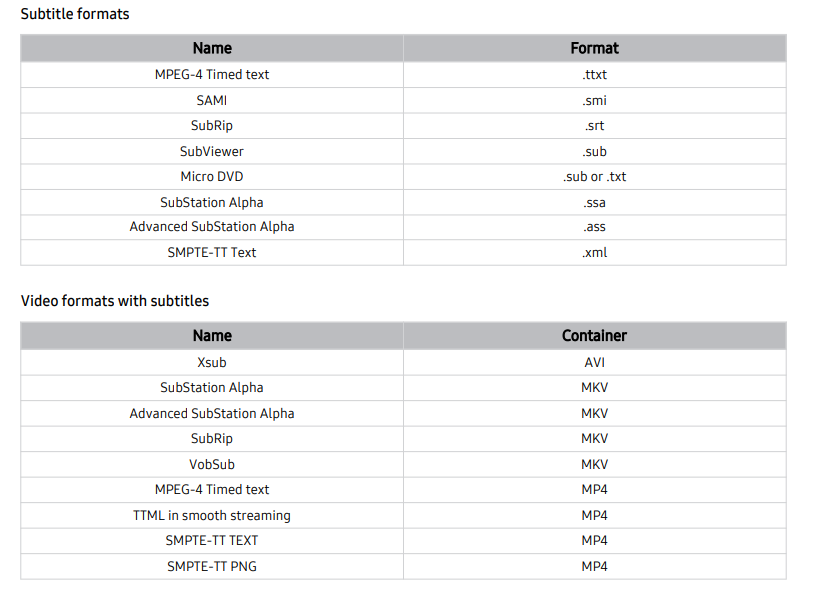
Supported video codecs (The Frame)
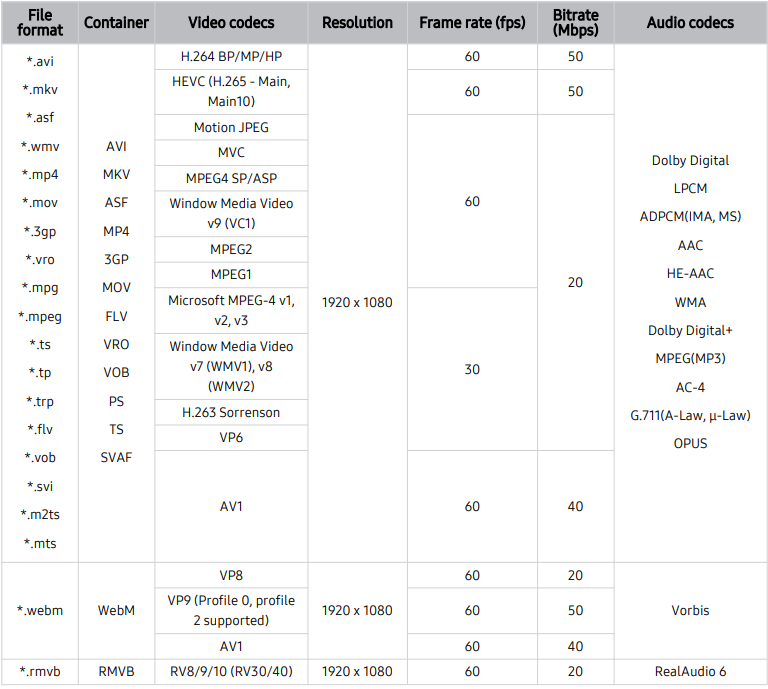
Other restrictions
- Codecs may not function properly if there is a problem with the content.
- Video content does not play or does not play correctly if there is an error in the content or container.
- Sound or video may not work if they have standard bit rates/frame rates above the TV’s compatibility ratings.
- If the Index Table is has an error, the Seek (Jump) function will not work.
- When playing video over a network connection, the video may not play smoothly because of data transmission speeds.
- Some USB/digital camera devices may not be compatible with the TV.
- HEVC codec is only available in MKV / MP4 / TS containers.
- The MVC codec is supported partly.
Video decoders
- H.264 FHD is supported up to Level 4.1 (TV does not support FMO / ASO / RS).
- HEVC FHD is supported up to Level 4.1.
- VC1 AP L4 is not supported.
- GMC 2 or above is not supported.
Audio decoders
- WMA is supported up to 10 Pro 5.1 channels, M2 profile.
- WMA1, WMA lossless / Voice are not supported.
- QCELP and AMR NB/WB are not supported.
- Vorbis is supported for up to 5.1 channels.
- Dolby Digital+ is supported for up to 5.1 channels.
- The supported sample rates are 8, 11.025, 12, 16, 22.05, 24, 32, 44.1, and 48 KHz, and differ with the codec
System and Support
Using the Time Functions and the Timers
- Set the current time and use the timer function.
- Settings General System Manager Time Try Now
- You can set the Clock manually or automatically. Once the Clock is set, you can view the current time on the TV anytime.
- You must set the clock in the following cases:
- The power cable is disconnected and then connected.
- The Clock Mode is changed from Auto to Manual.
- The TV is not connected to the Internet.
- No broadcast signals are received
Setting the clock automatically
- Settings General System Manager Time Clock Clock Mode Auto
- This function works only when the TV is connected to the Internet or is receiving digital broadcasts through a connected antenna.
- The accuracy of the time information received may differ with the channel and signal.
- If you get your TV signal from a cable broadcast receiver/set-top box or a satellite receiver/satellite set-top box connected to an HDMI or Component port, you must set the current time manually.
Changing the current time
- Settings General System Manager Time Clock Time Offset
- Time Offset adjusts the time through a network connection.
- This function is available only when Clock Mode is set to Auto, the TV fails to receive time information through normal broadcast signals, and the TV is connected to the Internet through a local area network.
Using the sleep timer
- Settings General System Manager Time Sleep Timer
- You can use this function to automatically shut off the TV after a pre-set period of time. You can set the sleep timer for up to 180 minutes after which it will turn off the TV.
- This function may not be supported in some viewing modes.
- Turning off the TV using the off timer
Settings General System Manager Time Off Timer
- You can set Off Timer to shut off the TV automatically at a ϑΧʪʀ̈fiʀ time. Off Timer is only available if the Clock has been set.
- To use this function, fiθϑϩ set the Clock ( Settings General System Manager Time Clock).
- This function may not be supported in some viewing modes.
- Reducing the energy consumption of the TV
- Settings General Eco Solution Try Now
- You can adjust the brightness level of the TV, reduce overall power consumption, and prevent overheating.
- This function may not be supported depending on the model.
Ambient Light Detection Try Now
- Automatically adjusts the brightness level of the TV, according to the ambient light level, to reduce power consumption.
- If Ambient Light Detection has adjusted the screen brightness to a too bright or dark level, you can select Minimum Brightness to manually adjust the minimum screen brightness.
- Minimum Brightness Try Now
- When Ambient Light Detection is turned on, you can manually adjust the minimum brightness of the TV screen.
- This function acts only when the value is less than the setting in Settings Picture Expert Settings
Troubleshooting
The TV image does not look as good as it did in the store.
- Store displays are tuned to a digital UHD channel or HD channel. If you are using analog cable, upgrade to digital cable.
- If you use an analog cable box or satellite box, upgrade to a digital cable box or satellite box and adjust the digital cable box and satellite box's video output resolution to UHD or HD. Be sure to use an HDMI cable to enjoy high quality videos.
- To connect the TV with your PC, make sure that your PC's graphic card supports UHD resolutions. For more information about the supported UHD resolutions, refer to "Supported Resolutions for UHD Input Signals.
The picture is distorted.
- The compression of video content may cause picture distortions, especially in fast moving pictures from sports programs and action movies.
- If the signal reception is weak or poor, screen distortion may be visible but it is not a malfunction. Mobile phones used close to the TV (within 3.2 ft) may cause noise on analog and digital channels.
The color is wrong or missing.
- If you’re using a Component connection, make sure that the Component cables are connected to the correct jacks. Incorrect or loose connections may cause color problems or a blank screen.
The picture is black and white.
- Use a composite cable when you connect AV equipment to the TV. If you are using the composite cable, connect the video cable (Yellow) to the VIDEO (Yellow / Green) input port. Check whether Grayscale is set to On
The picture won’t display in full screen.
- HD channels will have black bars on either side of the screen when displaying upscaled SD (4:3) content.
- Black bars will appear at the top and bottom of the screen when you watch movies that have aspect ratios different from your TV. Adjust the picture size options on your external device or set the TV to full screen.
Captions appear on the TV screen.
- Turn off the Caption function in Caption Settings. • Settings General Accessibility Caption Settings Caption
There is no sound or the sound is too low at maximum volume.
- Check the volume control of your TV, and then check the volume control of the external device (cable box or satellite box, DVD, Blu-ray, etc.) connected to your TV.
The picture is good but there is no sound.
- If you are using an external device, check the device’s audio output option. For example, you may need to change your cable box’s audio option to HDMI if the box connected to your TV is using an HDMI cable.
- To listen to computer sound, connect an external speaker to the computer’s audio output connector. If your TV has a headphone jack, make sure there is nothing plugged into it.
- Reboot the connected device by disconnecting and then reconnecting the device’s power cable.
No sound is heard.
- Check whether Digital Output Audio Format is set to Dolby Digital+. Set Digital Output Audio Format to Dolby Digital+ only when you play Dolby Digital+ (with Atmos) content.
- If you are using an AV receiver that does not support Dolby Digital+, you will hear no sound when you select
The speakers are making an odd sound.
- Make sure that the audio cable is connected to the correct audio output connector on the external device. For antenna or cable connections, check the signal information. A low signal level may cause sound distortions.
The sound is interrupted.
- The sound may frequently be interrupted when a Bluetooth speaker is used.
- Make sure that the Bluetooth speaker and the wireless access point are on a straight line, and the Bluetooth speaker is placed as close as possible to the TV.
- To minimize interruptions, we recommend a wireless access point that uses a 5 GHz frequency. If the problem persists, we recommend that you use a wired connection
The TV audio is not being played through the AV receiver.
- Make sure that the AV receiver is connected to the TV's HDMI (ARC) port with an HDMI cable. Confirm that the AV receiver is HDMI (ARC) compatible.
- If the AV receiver is not HDMI (ARC) compatible, connect the TV and the AV receiver with an optical cable
Weak or No Signal” displayed in TV mode/ cannot find channel
- Make sure that the external device is connected securely and turned on. Move to Sources to switch to other input sources.
Broadcasting is deactivated.
- Broadcasting is only available when Source is set to TV. Broadcasting cannot be accessed while you watch TV using a cable box or satellite box.
- Broadcasting cannot be accessed while a recording is in progress or the Timeshift function is running.
The video is OK but there is no audio.
- If you are using an HDMI connection, check the audio output setting on your PC. If you are using a DVI to HDMI cable, a separate audio cable is required.
- To listen to the computer sound, connect external speakers to the audio output connection of the computer.
How can I use Screen Mirroring
- To wirelessly connect the TV to your PC, read the instructions at PC Screen Sharing (Wireless) in Connection Guide, and then try to connect.
- Source Connection Guide PC Screen Sharing (Wireless) Confirm that the TV and your PC are connected to the same wireless network. To wirelessly connect the TV to your mobile device, read the instructions at Smartphone Screen Sharing (Smart View) in Connection Guide, and then try to connect.
- Source Connection Guide Smartphone Screen Sharing (Smart View) If the TV has difficulties connecting to your PC or mobile device due to surrounding radio interferences, change the frequency of the wireless access band, and then try to connect.
Wireless network connection failed. Unable to connect to a wireless access point.
- Make sure that no items that can generate electromagnetic interferences are placed between the TV and the wireless/wired access point.
- Check if the access point is turned on. If it is on, turn it off, wait 1 or 2 minutes, and then turn it on. Enter the correct password if required.
- If the wireless connection fails, connect the TV to the access point via a LAN cable. If the TV can connect to the Internet normally via the wired connection, there might be a problem with the access point. In this case, try using a different access point.
Wired network connection failed.
- Check if the LAN cable is plugged in on both ends. If it is plugged in, check if the access point is turned on. If it is on, turn it off, wait 1 or 2 minutes, and then turn it on.
- Auto IP configuration failed. Unable to connect to the network.
- Check if the LAN cable is plugged in on both ends. If it is plugged in, check if the access point is turned on. If the access point is on, turn it off, wait 1 or 2 minutes, and then turn it on. Disconnect and then reconnect the power cable of the TV, or press and hold the power button for 3 seconds.
There is no response even if the voice entry button is pressed.
- Try pairing the remote control with the TV.
During voice recognition, the heavy load message appears and the function does not work.
- Unplug and then plug the TV power cable and then try again after 1 minute and 30 seconds. It may take a while if the voice recognition server is being inspected.
- I want to see weather information of the desired area.
- Say with the area name included.
The TV is hot.
- Watching TV for an extended period of time causes the panel to generate heat. The heat from the panel is dissipated through internal vents running along the top of the TV.
- The bottom, however, may feel hot to the touch after extended use.
- Children watching TV need constant adult supervision to prevent them from touching the TV. This heat, however, is not a defect and does not affect the TV's functionality.
The TV smells like plastic
- This smell is normal and will dissipate over time
The settings are lost after 5 minutes or every time the TV is turned off.
- If Usage Mode is set to Retail Mode, the TV's audio and video settings are automatically reset every 5 minutes.
The TV is tilted to the side
- Remove the base stand from the TV and reassemble it
The stand is wobbly or crooked.
- Refer to the Quick Setup Guide and make sure that the stand is assembled correctly.
A POP (TV’s internal banner ad) appears on the screen.
- PIP is available only when an external device is connected with an HDMI or Component cable. Note that the function is unavailable when Smart Hub is active.
- This function may not be supported depending on the model or geographical area.
The TV is making a popping noise
- The expansion and contraction of the TV's outer casing may cause a popping noise. This does not indicate a product malfunction. The TV is safe to use.
The TV is making a humming noise
- Your TV utilizes high-speed switching circuits and high levels of electrical current. Depending on the TV's brightness level, the TV may seem slightly noisier than a conventional TV.
- Your TV has undergone strict quality control procedures that meet our demanding performance and reliability requirements.
- Some noise coming from the TV is considered normal and is not an acceptable cause for an exchange or refund.
The TV narrates the screen events in voice-over.
- To turn off Voice Guide, move the focus from Accessibility Shortcuts to Voice Guide and then press the Select button.
- You can turn on or off Voice Guide. To run Accessibility Shortcuts, see the following:
- Press and hold the (Volume) button on your Samsung Smart Remote.
- Press the CC/VD button or press and hold the MUTE button on your standard remote control.
The wireless network connection failed.
- Confirm your wireless modem/router is on and connected to the Internet.
The wireless network signal is too weak.
- Position your wireless router, modem router, or access point in a central location. Avoid putting it in a corner.
- Use a wireless repeater to get an instant boost in your wireless signal strength. Place the repeater halfway between your wireless router and your TV.
Anynet+ does not work.
- Confirm that the device is an Anynet+ device.
- The Anynet+ system supports Anynet+ devices only. Check if the power cord of the Anynet+ device is properly connected. Check the cable connections of the Anynet+ device.
I want to start Anynet+.
- Move the focus to the Anynet+ device at Source, and then press the up directional button.
- Check if the Anynet+ device is properly connected to the TV, and then select
The connected device is not displayed.
- Check whether the device supports Anynet+. Anynet+ devices must be connected to the TV using an HDMI cable.
- Make sure the device is connected to your TV with an HDMI cable. Some HDMI cables may not support Anynet+. Check whether the HDMI cable is properly connected.
The TV audio is not being played through the receiver
- Make sure that the receiver is connected to the TV's HDMI (ARC) port with an HDMI cable. Confirm that the receiver is HDMI (ARC) compatible.
- If the receiver is not HDMI (ARC) compatible, connect the TV and receiver with an optical cable.
Some files can't be played.
- This problem may occur with high-bitrate files. Most files can be played back, but you might experience problems with high-bitrate files.
Reset Settings
- Resets Picture, Sound, Broadcasting, and all other settings, except for the network settings, to the default settings.
Reset Smart Hub
- Resets all Smart Hub settings to their factory defaults and deletes all information related to Samsung accounts, linked service accounts, Smart Hub service agreements, and Smart Hub applications.
The TV is hot.
- Watching TV for an extended period of time causes the panel to generate heat. The heat from the panel is dissipated through internal vents running along the top of the TV.
- The bottom, however, may feel hot to the touch after extended use. Children watching TV need constant adult supervision to prevent them from touching the TV.
- This heat, however, is not a defect and does not affect the TV's functionality.
The picture won’t display in full screen
- HD channels will have black bars on either side of the screen when displaying upscaled SD (4:3) content.
- Black bars will appear at the top and bottom of the screen when you watch movies that have aspect ratios different from your TV. Adjust the picture size options on your external device or set the TV to full screen.
The "Mode Not Supported" message appear
- The output resolution of the attached device is not supported by the TV. Check the TV's supported resolutions and adjust the external device’s output resolution accordingly.
The Captions item in the TV is grayed out.
- When an external device is connected with an HDMI or Component cable, the Caption function is unavailable. Adjust the caption setting on the external device.
The stand is wobbly or crooked.
- Make sure the indicator arrows on the stand and stand holder are properly aligned
The remote control and/or voice control does not work.
- The TV ships with protective stickers covering some of the sensors. Make sure all of the stickers have been removed.
PIP is not available.
- PIP is available only when an external device is connected with an HDMI or Component cable. Note that the function is unavailable when Smart Hub is active
The TV is making a popping noise.
- The expansion and contraction of the TV's outer casing may cause a popping noise. This does not indicate a product malfunction. The TV is safe to use.
The TV is making a humming noise.
- Your TV utilizes high-speed switching circuits and high levels of electrical current. Depending on the TV's brightness level, the TV may seem slightly noisier than a conventional TV
- . Your TV has undergone strict quality control procedures that meet our demanding performance and reliability requirements. Some noise coming from the TV is considered normal and is not an acceptable cause for an exchange or refund.
The volume of the external device cannot be adjusted.
- Check the cable connection between the TV and the external device.
- When connecting an external speaker such as home theater via HDMI, make sure it is connected to the HDMI (eARC) port on the TV. Make sure that the
I want to turn off and on the TV and audio device at the same time.
- When you connect the Samsung Soundbar to the TV via Bluetooth, the power turns off and on together. It may not be supported depending on the Samsung Soundbar model.
- When you connect an audio device that supports HDMI eARC to the HDMI (eARC) port on the TV, the power turns off and on together. HDMI (ARC) is supported by some models. Check the HDMI port name of the purchased product's model.
The captions are not provided on a digital channel.
- Some channels may not have caption data.
- When watching a channel on an external device such as set-top box and cable box, turn on the caption function on the device. For more information, contact your service provider
The "Mode Not Supported" message appears.
- Adjust the output resolution of the external device to a resolution supported by the TV.
The video is OK but there is no audio.
- If you are using an HDMI connection, check the audio output setting on your PC.
- If you are using a DVI to HDMI cable, a separate audio cable is required.
- To listen to the computer sound, connect external speakers to the audio output connection of the computer.
The PC screen does not appear
- When the PC screen does not appear or the PC is not recognized, check the power supply of the PC and then reconnect the HDMI cable between the PC and
- TV. When the symptom persists, check that the PC is in Sleep mode.
- When the set resolution is not matched, the screen may For the PC supported resolution, see 'Read Before Connecting a Computer (Supported Resolutions).
Wireless network connection failed.
- Unable to connect to a wireless access point.
- Make sure that no items that can generate electromagnetic interferences are placed between the TV and the wireless/wired access point.
- Check if the access point is turned on. If it is on, turn it off, wait 1 or 2 minutes, and then turn it on.
Enter the correct password if required.
- If the wireless connection fails, connect the TV to the access point via a LAN cable.
- If the TV can connect to the Internet normally via the wired connection, there might be a problem with the access point. In this case, try using a different access point.
Wired network connection failed.
- Check if the LAN cable is plugged in on both ends. If it is plugged in, check if the access point is turned on. If it is on, turn it off, wait 1 or 2 minutes, and then turn it on.
Auto
- Unable to connect to the network.
- Check if the LAN cable is plugged in on both ends. If it is plugged in, check if the access point is turned on.
- If the access point is on, turn it off, wait 1 or 2 minutes, and then turn it on.
- Disconnect and then reconnect the power cable of the TV, or press and hold the power button for 3 seconds.
The TV is making a humming noise.
- Your TV utilizes high-speed switching circuits and high levels of electrical current. Depending on the TV's brightness level, the TV may seem slightly noisier than a conventional TV.
- Your TV has undergone strict quality control procedures that meet our demanding performance and reliability requirements.
- Some noise coming from the TV is considered normal and is not an acceptable cause for an exchange or refund.
Accessibility Guidance
Turning on Voice Guide
- Press the CC/VD button on the remote. The Accessibility Shortcuts menu appears.
- Press the up or down directional buttons on the remote to move to and highlight the Voice Guide option.
- Press the Select button on the remote to turn Voice Guide on or off.
- Close the menu either by pressing on the remote or by pressing the right directional button to highlight
- Close, and then pressing the Select button.
Turning on Video Description
- Press the CC/VD button on the remote. The Accessibility Shortcuts menu appears.
- Press the up or down directional buttons on the remote to move to and highlight the Video Description option.
- Press the Select button on the remote to turn Video Description on or off.
- Close the menu either by pressing on the remote or by pressing the right directional button to highlight
- Close, and then pressing the Select button.
Learning TV Remote
- Press the CC/VD button on the remote. The Accessibility Shortcuts menu appears.
- Press the up or down directional buttons on the remote to move to and highlight the Learn TV Remote option.
- Press the Select button on the remote. You are now in the e-Manual and specifically on the Learn TV Remote page.
- Press a button on the remote. The name and function of the button are heard.
- When you have finished and want to exit the e-Manual, press the button twice to exit Learn TV Remote.
- This function is only available when Voice Guide is enabled.
- Accessing the main accessibility menu to change Voice Guide settings
- You can also go to an accessibility menu from the TV settings menu. This provides more options, for example, to change the speed of Voice Guide.
- The TV will not verbalize this menu unless Voice Guide is already turned on.
Press the button.
- Press the left directional button until you reach Settings.
- Press Select and a menu will open.
- Press the down directional button to reach General, and then press Select to open this menu.
- Use the directional buttons to go to the Accessibility menu, and then press Select to open this menu.
- The menu will appear with Voice Guide Settings being the first menu. Highlight Voice Guide Settings, and then press Select.
- A menu appears with the options to change Voice Guide and Volume, Speed, Pitch.
- Select the menu using the directional buttons, and then press Select.
See other models: SM-A515UZKNVZW VG-SOCR85/ZA DVG45T6200W/A3 SM-N960UZKFATT SM-G970UZWATMB
